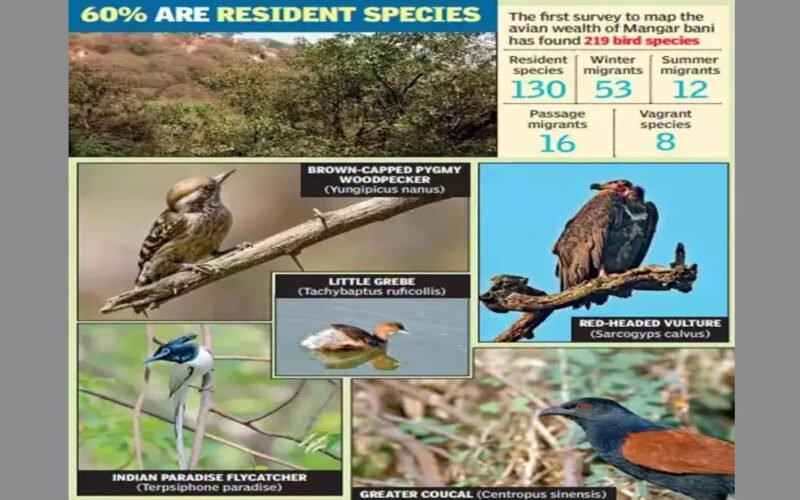June 7, 2021 – The first survey to map the avian wealth of Delhi-NCR’s sole ‘forest’, Mangar Bani, located near Camp WildHawk, has revealed that the Aravali grove isn’t just rich in the number of species it sees or hosts but also especially diverse. The survey found 219 species of birds in a 17.1sqkm area. Mangar Bani is also an important breeding habitat for insectivorous summer visitors such as the Indian pitta and Indian paradise flycatcher, which are rare elsewhere in the region.
The survey was carried out by wildlife researchers in 2019 and 2020 and was supported by the Centre for Ecology, Development, and Research (CEDAR) and the Delhi Bird Society. Two of its important inferences are that Mangar needs legally protected status as a forest and it is necessary to protect and revive springs and streams in the Aravalis for the conservation of this fauna. The protected area around Mangar Bani is still awaiting notification as a forest, even though the Haryana govern.
According to the survey, the rich bird fauna of the Haryana Aravalis can provide a strong basis for future conservation and ecologically sensitive land-use planning in Delhi NCR. The Indian peacock, which is the national bird and is protected under the Wildlife Protection Act, 1972, is found abundantly in Mangar, it said. The survey also found five raptor species, including the king vulture and Egyptian vulture, which are in the ‘endangered’ category of the International Union for Conservation of Nature’s Red List.
“We recorded a total of 129 species during the transect surveys of 2019-20. We also referred to data from 28 other bird walks between 2015 to 2020. Records of an additional 90 species were compiled from eBird, bringing the total number of species to 219. Among these, 130 (60%) are resident species, 53 (24%) are winter migrants, 12 (5%) are summer migrants and 16 (7%) are passage migrants,” said Ghazala Shahabuddin, ecologist and senior fellow at CEDAR, Delhi.
Six bird species on the decline across the country, such as the yellow-crowned woodpecker and short-toed snake eagle, were found to be thriving in Mangar. “Our study thus suggests that the Mangar landscape is a crucial habitat for birds of the northern Aravalis of Haryana. The diversity of birds indicates good quality forest and other resources available for birds,” wildlife researcher Sunil Harsana, who was part of the team that carried out the survey, said.
The survey also compared the bird diversity of Mangar with that of five other scrub deciduous forest habitats in Delhi-NCR — Sanjay Van, Aravali Biodiversity Park (Vasant Vihar), Aravali Biodiversity Park (Gurugram), Asola Bhatti Wildlife Sanctuary, and the Jawaharlal Nehru University campus.
It was also observed that apart from Asola Bhatti Wildlife Sanctuary, Mangar has the highest bird species density among the six locations with the same forest habitat. While the Asola Bhatti sanctuary is a protected area, the Aravali areas of Mangar do not enjoy the same status, as Haryana is yet to decide on the definition of forests and demarcate natural conservation zones.
“Interestingly, several forest species of the northern Aravalis frequently recorded in Mangar are now seen in only a few other habitats in the region. This list includes the Indian pitta, white-bellied drongo, yellow-crowned woodpecker, Indian paradise flycatcher, and white-browed fantail, among others,” said Misha Bansal, project assistant and nature educator, CEDAR, Delhi.
The resident species of Mangar include those seen frequently in well-wooded habitats in Delhi, such as the yellow-footed green pigeon, plum-headed parakeet, lesser golden-backed woodpecker, and grey hornbill. Other resident birds, like the red-vented bulbul, Oriental magpie-robin, common tailorbird, jungle babbler, and ashy prinia, can be widely found in human-modified habitat within Delhi, including gardens, abandoned lots, and parks.
Besides its resident species, Mangar hosts 12 summer visitors that breed in its forest. There are confirmed nesting records of the Indian pitta, Indian paradise flycatcher, black-headed cuckoo shrike, and crested bunting.
As many as 16 passage migrants, including the rosy starling, western-crowned warbler, and ashy drongo, stop at Mangar bani during their annual migration. The forest has also reported 27 birds of prey (owls and raptors).
The survey concluded that for conservation of the entire assemblage of tropical dry forest bird species, it is necessary to protect and revive the springs and streams of the Aravalis. Conservation of Mangar bani along with its surrounding forests contributes immensely to NCR’s avifaunal biodiversity, it stated. “We believe our study of the rich bird fauna of the Haryana Aravalis can provide a strong basis for future conservation,” said Bansal.
Researchers stressed that without forest restoration and water conservation in the Mangar landscape, the region may lose these important riparian habitats without any chance of revival in the future. “There is a need to explore the rest of the Aravalis of Gurugram and Faridabad, where some good forest remnants and water sources still exist so that larger patterns in bird distribution can be understood,” Shahabuddin said.
The Delhi Bird Society pointed out that Mangar bani and some of the surrounding forests are in relatively good condition due to the long-term protection they have received from the local community. If the avifauna is to be sustained, however, this will not be sufficient, as the forest covers a mere 17sqkm. “The bird fauna is dependent on the continuous mosaic of forests and other relatively undisturbed areas with low human population density cutting across the Delhi and Haryana Aravalis, covering an area of approximately 200 square kilometers. Much of this area currently has no legal protection,” said Pankaj Gupta, a member.
Meanwhile, the state forest department said they are working on a habitation improvement plan for the Aravalis. “We are working to increase Haryana’s forest cover from 7% to 20%,” a senior official said.
